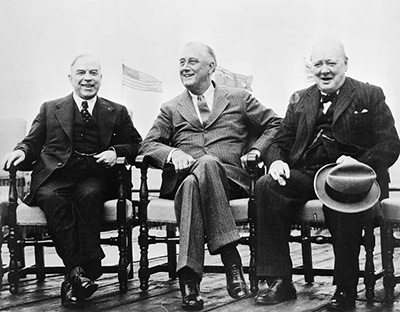
WWII: Maginot Line | Normandy | V-Weapon Sites | Arnhem
Further afield: Crete
| Home Tracing Military Ancestors Travel Advice CWGC Cemeteries Iron Harvest News Book Reviews Glossary Links Contact Me Normandy Landings:
 
|
The PlanThe planning committee of COSSAC worked feverishly throughout the spring and summer of 1943, with the location for the landings, Normandy, being decided in June at a conference chaired by Lord Louis Mountbatten. Normandy offered many advantages to the Allies – German defences were weaker than in the Pas de Calais region and the beaches were relatively more sheltered due to the Contentin peninsula which acted like a huge breakwater. Significantly, Normandy was also still within range of Allied fighters and fighter-bombers based in southern England.
Events were now moving fast and, at the Quebec Conference in August 1943, Churchill and Roosevelt chose 1st May 1944 as “D-Day”, the date of the invasion and liberation of Europe, code-named “Overlord”. In December Roosevelt appointed the American, General Dwight D. Eisenhower, as Supreme Allied Commander for the invasion. He would be supported by British deputies; Air Chief Marshal Sir Arthur Tedder as Deputy Supreme Allied Commander, Air Marshal Sir Trafford Leigh-Mallory as commander of the Allied Expeditionary Air Force and Admiral Sir Bertram Ramsey as the Naval Commander-in-Chief. The commander of the Eighth Army at El Alamein, General Bernard Law Montgomery, was appointed to head 21st Army Group – the land component for the invasion comprising the First American and Second British Armies. On their arrival at COSSAC in January 1944, Eisenhower and Montgomery agreed some significant changes to the original plan proposed by General Morgan the following year. They extended the invasion area from a three-division to a five-division front, hoping that this lengthened frontage would make it more difficult for the Germans to concentrate their armoured reserves against the landings. Morgan’s plan also called for a reduced airborne division to make a direct assault on the city of Caen. Montgomery dismissed this idea and instead proposed the landing of three airborne divisions – two American in the west at the base of the Contentin Peninsula and a British division in the east, north of Caen. On D-Day these highly trained troops would have a variety of tasks, but essentially it was hoped they would act as a blocking force to protect the flanks of the landing during its vulnerable early stages. To assist their forces in the initial assault phase, the Allies conducted one of the most complex and successful deception plans in the history of modern warfare. Operation Bodyguard, as it was known, had four major aims. To persuade the German High Command that:
Operation Fortitude, a sub-operation of Bodyguard, was key to this success. By using double agents such as the Spaniard, Garbo, and the radio traffic from a fictitious army group in the south-east of England supported by dummy tanks and landing craft, German military intelligence become convinced that the main assault would come in the Pas de Calais region. As a result huge resources were diverted to the construction of massive concrete fortifications opposite the Kent coast. In fact, so convinced were the Germans by the deception that, even after the landings in Normandy had begun, they still believed this to be a decoy for the main invasion across the Straits of Dover. Accordingly, they withheld the release of infantry and armour reserves that may have been decisive in the early stages of the Battle of Normandy. |
